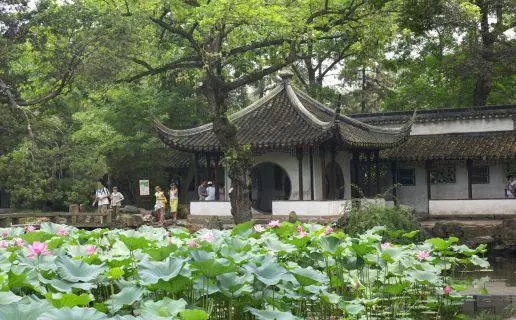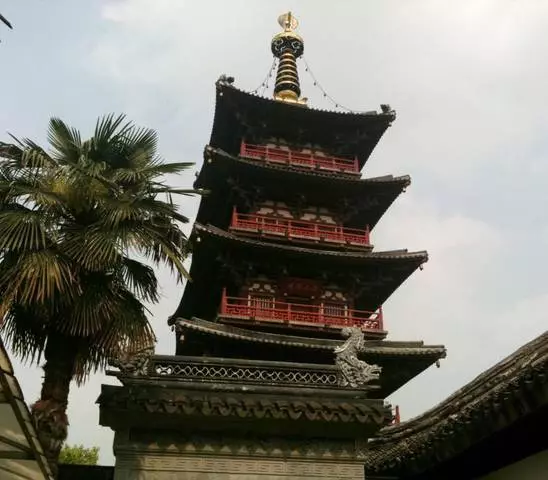Suzhou (Suzhou) is homeland Shelka, this urban district is located in Jiangsu province, in a hundred kilometers to south-west from Shanghai, close to Thai Lake. This area is the most fertile edge located in Delta Yangtze. In 514 BC. The prince of the kingdom of gave an indication of his official from Zisyu, so that he would build the city in this area. Since that time, two and a half thousand years have passed. Throughout its history, Suzhou always attracted merchants, it was always noisy here. To this day, the old location of urban streets along the channels allows you to call Suzhou "Eastern Venice".
The city and now keeps the patriarchal appearance inherent in him. During walks along his deaf streets, tourists can hear from the vendors created by the merchants, and the laughter of the local citizens. These lots are typical in South China. Nowadays Suzhou is an association of ancient history and modernity. The city consists of two modern areas: the new Suzhou and Industrial Park of Sino-Singapore cooperation. Drains of Suzhou - and historical, and modern - save the traditional culture of the Middle Kingdom.
From the distant distance of Suzhou is able to impress the greatness of the city walls and the gate, not to mention the old pagoda, which causes his feeling a feeling of some kind of magic.
Gardens in Suzhou
All those who visited this city appreciated not only his preserved ancient appearance, but also were impressed with his garden-park art. In antiquity about these beauties, they spoke like this: the southern China gardens are of glory in the whole state, and the gardens in Suzhou are the most beautiful in the southern part of the country. The beginning of the construction of gardens and parks in Suzhou dates back to the sixth century BC, while Rules Prince W. The construction of private gardens occurred in the fourth century - during the Dynasty East Jin. Since that time, the construction of the gardens continued constantly. During the Ming and Qing dynasties (from the fourteenth century of the twentieth century), Suzhou was the most lively terrain in the Middle Kingdom - during the peak of its development in the city there were more than two hundred park ensembles. Because of this, Suzhou and began to call the "earthly paradise".
And in our time in the city you can see dozens of these gardens in good condition. The most famous is Zhozhäuan Parks, Vanchesuan, Huan Sushanzhuang and Lyuan. Each of them boasts its own style, they are all fulfilled in elegant layout technology, with high quality architectural art and inner culture.
Garden Zhogenyuan
Garden Zhogenjuan (or the "garden of a modest official") - occupies a territory of four hectares, more than half of this area is occupied by reservoirs - this is the largest urban park ensemble. The pavilions of the ensemble are located near the water - along the shores of the ponds or directly on them - on the piles. They are connected by bridges and transitions. The most famous among them is the pavilion of thirty six mandarin ducks. These birds that settled on local reservoirs is a symbol of loyalty in marriage. This garden was arranged in retirement censor in 1513, however, when he died, his heir lost his father's garden in just one night. Then the garden was elected leader of Taipinov as a residence.

Garden Lyuan (garden of unevenness)
The Garden of Lyuan (or the "garden of unevenness") is the original collection of mountains created artificially, he became known in the Qing period. The main highlight of the park are water ducts and ponds - on their shores are these the most artificial mountains that are covered with green plantings.
Pavilion blue waves
The most vintage city garden is a blue wave pavilion (or zanlan). It was founded in 1044. Here, tourists can see piles of stones, green bamboo groves and artificial hills. The characteristic feature of the park landscape is the lack of a circumferential wall, there is such a natural fencing like mountains. The Hall of Bright Trail keeps the images cut in the tree more than five hundred well-known personalities, which influenced the development of the city.
Garden of lion cave
The garden of the Lion cave, which was built during the dynasty of the Yuan (thirteenth - the fourteenth century), became famous because of the stone sticks having the form of Lviv - why was his name.
Temple Hanshan
Hanshan Temple erected in the north-west of Suzhou, in the sixth century. Several times the temple was destroyed because of fires. That building, which is worth now, was erected at the end of the Qing period (seventeenth - twentieth century). The main buildings located here are Mahavir Hall, a sutra hall, bell tower, a steel corridor and the building of the maple river. Since 1979, every year on December 31, the temple bell ringing makes the ancient customs and at the same time announced the arrival of the new year.

Paired Pagoda
In the east of the city there are steam pagodas. They were erected in 982, during the reign of the Sun dynasty. Previously, the Pagoda was located on two parties from the entrance to the Baguo monastery, but he was destroyed in 1860. Close to Podgoda is the foundation of this destroyed building. A large number of her residues is located throughout the area, there are including bas-reliefs that were created during the Sun dynasty.
Bridge Fenziao
Fenziao Bridge is located on the ancient canal at a distance of four kilometers to the west of Suzhou. The landscape area, which adjoins it, has an area of forty-five hectares. Street shopping shops offer a wide selection of products of local crafts: paintings, calligraphic work, flakes from silk and others. From the construction of an ancient school, tourists can catch the sounds of lute "Peba", and in a windy day you can listen to the bell ringing from the Khanshan monastic tower.
Zhojuang
Zhojujan in the Middle Kingdom know as the first settlement on the water. His age is nine centuries. Along the country, it is known for the labyrinths of the channels, the buildings of the times of Qing and mines and the local traditions. On the territory of 0.4 square kilometers there are about a hundred ancient yards in the traditional style, more than six tens of brick arches and fourteen vintage bridges. The latter have the most distinctive form, but the most characteristic of them are paired bridges Shuangsiao. They are erected from stone in the era of mines, are characterized by simplicity and strength of the structure.

